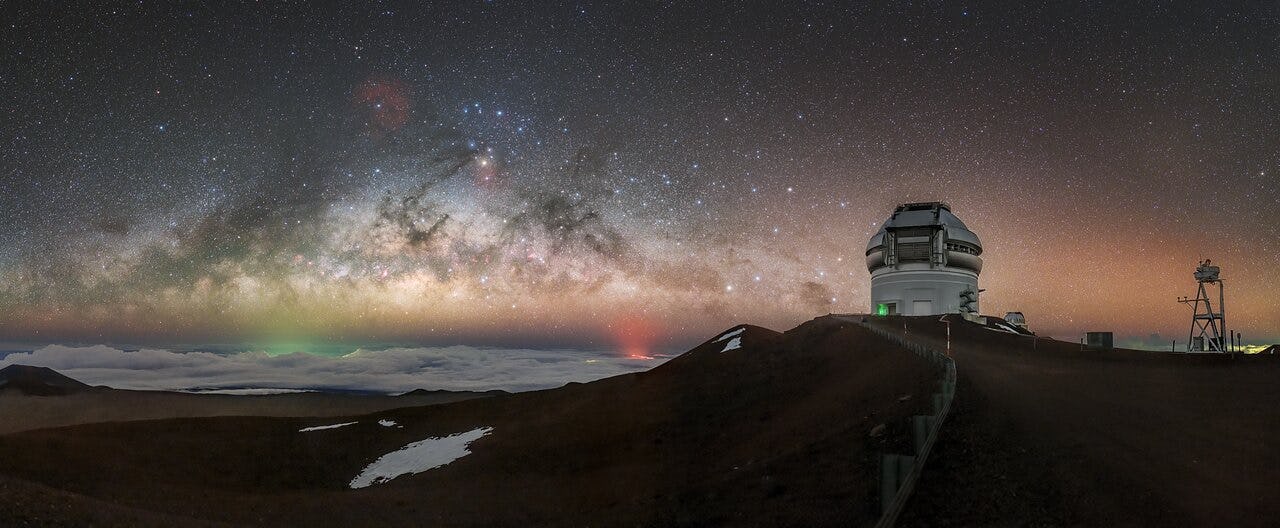
The whole universe knows when a supermassive black hole is eating: these monstrously massive objects at the hearts of galaxies feast on infalling matter, and that process generates radiation so bright it can outshine the billions of stars in its host galaxy. These active galactic cores are called quasars.
Sometimes, when galaxies merge together, you can spot multiple quasars in what is becoming a single larger galaxy. Such galactic mergers are thought to be a common part of galaxy evolution, and scientists have observed galaxies with more than one quasar throughout the universe — but very few examples in the very distant universe.
In a new study published Wednesday in the journal Nature, researchers describe the discovery of a galaxy with two active quasars that’s roughly 29 billion light years away. A galaxy formed by the merger of two galaxies when the universe was just three million years old, the first time such a pair of quasars have been found at that time.
“We don't see a lot of double quasars at this early time. And that's why this discovery is so exciting,” study lead author Yu-Ching Chen, a graduate student in astronomy at the University of Illinois at Urbana-Champaign, said in a statement. It’s a finding he says “will eventually tell us about the emergence of supermassive black holes in the early Universe, and how frequent those mergers could be.”
And understanding galaxy mergers and supermassive black holes may help scientists understand star formation in galaxies, and ultimately, the processes that lead to the evolution of planets like Earth, where lifeforms can contemplate distant black holes.

Lunch at cosmic noon
Using an array of instruments, the researchers discovered two supermassive black holes potentially orbiting each other as a binary pair about 10,000 light years apart in a single galaxy, a tell-tale sign that this galaxy resulted from the merger of two small galaxies. That galaxy existed during what astronomers call “cosmic noon,” the period about 10 to 11 billion years ago when star formation across the cosmos was at its peak.
It was not an easy discovery. Even finding two quasars in one galaxy near Earth is difficult, because most such pairs are so close, they cannot be distinguished unless they are both actively feeding, that is, accrediting inflating material. According to a media release from the Gemini North observatory in Hawaii, which was involved in the study, typically only one in 100 supermassive black holes is accreting at any given time.
Uncovering this unlikely feeding pair of remarkably distant supermassive black holes began with the Hubble Space Telescope, which returned the first signs of the distant quasars.
Researchers then turned to the archived observations of the European Space Agency’s Gaia space telescope, which scans vast swaths of the sky on a regular basis to map more than two billion celestial objects and monitor them for changes. Gaia’s observations of the quasars found by Hubble showed a “jiggle” that suggested changes in the two quasars.
The research team then used instruments from the Gemini North Observatory, NASA’s Chandra X-ray Observatory, and other instruments to confirm the findings.
“The confirmation process wasn’t easy and we needed an array of telescopes covering the spectrum from X-rays to the radio to finally confirm that this system is indeed a pair of quasars,” University of Illinois astronomer and study co-author Yue Shen said in a statement.
The researchers believe the distant and ancient galaxy merger shows a galaxy on its way to becoming an elliptical galaxy, which is considered the endpoint of galactic evolution. Elliptical galaxies tend to contain older stars and exhibit little new star formation.
Just how such a galactic merger at the peak of star formation at cosmic noon leads to an aged galaxy devoid of long stars is a focus of ongoing research. Some research suggests that supermassive black holes may limit star formation in galaxies.







